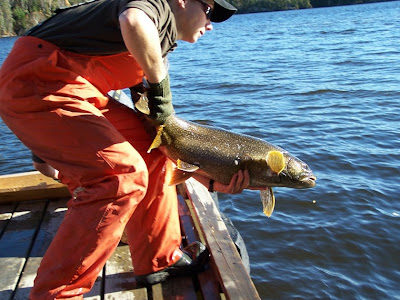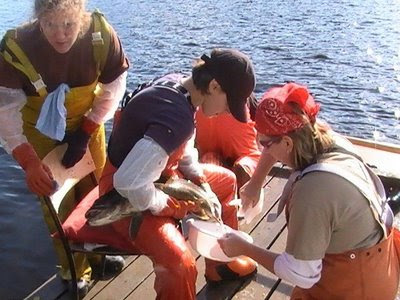


Nadine Thebeau, the area biologist for Red Lake, says the Ministry of Natural Resources has discovered a potential reason why lake trout are not reproducing in Pipestone Bay.
Sediment samples taken from spawning areas of the lake trout show levels of manganese high enough to be lethal to lake trout eggs.
Thebeau and her band of MNR researchers have known for quite some time that trout eggs were not surviving in most areas of Pipestone Bay but that the eggs would survive if taken to virtually anywhere else in the lake.
Manganese, she points out, is naturally occurring in the rock of Pipestone Bay. It remains to be seen why manganese is causing a problem now when, presumably, it wasn't a problem in the past.
Nadine's research also has shown that Pipestone is by far the favored spawning place for lake trout.
The MNR discovered in a study in 2001 that there were no lake trout in the lake that had been born since 1989. The MNR subsequently changed fishing regulations for Red Lake's lake trout to catch and release only and began netting spawning lake trout in the fall, stripping them of eggs and milt and raising the fingerlings in a hatchery. About 100,000 fingerlings have been released back to the lake each year since.
Nadine didn't speculate on what caused the manganese problem but a likely culprit was the forest fire that burned off the north shore of Pipestone Bay in 1986. We may never know how that increased manganese levels in the bay sediment but it occurs to me that perhaps the manganese from the soil around the rock had been taken up by the trees, as are other elements. The fire turned the trees to ash and the ash would have eventually made its way into the bay.
If that's what happened then the problem should diminish over time as there is now a dense covering of new trees growing in the old burn site. That would stop further manganese from leaching and eventually the manganese that's in the bay will be covered by normal sediments.
And there's evidence that the trout situation might indeed have started to turned around.
We are finally seeing young trout again. Our anglers caught and released many lake trout in the 22-26 inch range the last couple of years. These fish were likely less than 10 years old.
None of these were the nursery-raised fish. They can be recognized because they have one of their fins clipped, a different fin for each year. So the trout are successfully spawning again, at least a little, on their own.
The MNR team, however, did catch one of the hatchery fish as part of their spawning project last fall.
The hatchery-raised fish have been released at the eastern end of the lake in an attempt to get them to spawn somewhere other than Pipestone Bay. It may be working since only one was caught trying to spawn in Pipestone.
It should be noted that no one has said the elevated levels of manganese in Pipestone's sediments pose a health hazard to humans. It also doesn't seem to have any effect on other species of fish. Northern pike and walleye populations are very healthy.
Lake trout eggs are about the most sensitive organisms known in nature. Anything out of the ordinary can disrupt their development.
Forest fires, of course, are natural phenomena in the Boreal Forest. In fact, virtually every inch of the Boreal Forest burns every 80-120 years.
Red Lake's lake trout must have lived through hundreds of forest fires over the 10,000 years since the last ice age.
They are a long-lived fish and perhaps were just able to outlive the effects of the forest fires on Pipestone.
While we wait for the lakers to once again become a self-sustaining population, there are a number of things anglers can do.
1. Record the numbers of tagged fish and also note their length and where they were caught.
2. Check any lake trout you catch for a clipped fin before releasing it.
3. Record lengths of all your trout. Don't weigh these fish as the weighing process can harm them. Always quickly return the fish to the water. If possible, don't even bring them aboard the boat, just measure them in the water and turn them loose.
4. Follow fishing regulations that require you to use lures with single, barbless hooks when fishing specifically for lake trout. (You can use any type of lure for other species.)
Regulations also stipulate that you cannot use live or dead bait when lake trout fishing.
5. And finally, of course, follow regulations that require you to immediately release any lake trout you catch.
Click to go back to our website
Click to see the latest on the blog


1 comment:
Dan, It's great to hear that they are making progress on the lake trout problem. Like you said, they have lived through hundreds of years and many forest fires. Mother nature has a way of taking care of her own. Dave
Post a Comment